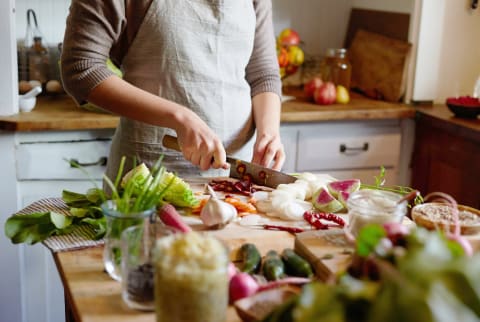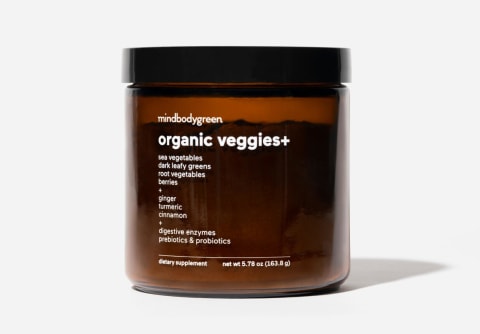Advertisement
I'm A Registered Dietitian: This Is The Trick I Swear By For Eating More Plants In The New Year


As we come up on the new year, it's a time many people take to consider ways they may be able to improve their health habits. A simple goal you could set might be aiming to eat more plants. Not necessarily plants only—just a lot more of them.
I've found, both personally and professionally, that the extremes aren't actually our best option, and that the best thing we can probably do for our health is just that simple: Eat more plants. My new book, The Plant-Forward Solution, dives into the science that supports this. You don't have to just take my word for it, research exists to back up the idea that adding more plants to any diet is beneficial.
So if you're going to try to be more plant-forward this year, here's one of my favorite tricks for getting more plant foods into your favorite meals.
My go-to way to eat more plants.
While eating more plants in general is a great goal for the new year, focusing on plant proteins should be part of that, as well—after all, many vegan protein sources are also good sources of fiber and phytonutrients that you won't get from animal proteins.
One of my best tricks for getting more plant proteins into the diet is what I call "going 50/50." It goes like this: Simply swap half of the protein in a favorite recipe for a plant protein. Animal and plant proteins are not sworn enemies. In fact, they can complement each other quite nicely in meals.
A good rule of thumb is to swap ¼ cup pulses (beans, chickpeas, lentils, etc.) or an ounce of tofu for every ounce or two of meat. An example where it's a more seamless swap might be trading in brown lentils for half of the ground meat in a sauce (like in the recipe below!). You're getting all the benefits of the plant protein and the volume, but you still get the meaty flavor.
For chicken, I like to use chickpeas as a swap. That's an example where it's a bit more of a stretch—you're not putting the chickpeas in there to mimic the taste or texture, but it just works together well.
Other things to keep in mind.
Once you start looking at your diet with a plant-forward lens, you might be surprised how many of your go-to meals are already mostly plant-based. For example, many people eat plant-based breakfasts—like smoothies, oatmeal, or avocado toast. If you start to realize that breakfasts or lunches full of plants leave you satisfied, maybe consider trying to use that meal as a place to keep up with your plant intake.
On the other hand, if you don't have many nutritious plant foods in your diet to start with, but you're ready to take the plant-forward plunge, don't try to do it all at once. Start by just experimenting: Try to incorporate a plant-based meal a few times a week, and then work your way up from there. You'll very likely be more successful in the long run than if you try to make a dramatic shift all at once.
How to make my "meaty" Bolognese.
Lentils and mushrooms stand in as a full or partial meat replacement in this plant-centric, dairy-free Bolognese. You have the option of going 50/50 by adding some ground beef or going fully plant-powered with no meat at all. And the options don't end there. Serve this over spaghetti squash or zucchini "noodles," or choose wheat-based or legume-based spaghetti noodles—or anything really!
Ingredients
- 8 ounces cremini or shiitake mushrooms, quartered
- ½ medium yellow onion, roughly chopped
- 3 cloves garlic, peeled
- 1 tablespoon extra-virgin olive oil
- Salt and black pepper
- 2 tablespoons tomato paste
- 1½ teaspoons dried oregano leaves
- ¼ teaspoon crushed red pepper (optional)
- ½ cup red wine or 100% pomegranate juice (see note)
- 1 (15-ounce) can crushed tomatoes
- 1½ cups cooked (one 15-ounce can) green, brown, or black lentils
- ½ cup canned coconut milk (full-fat or light)
- 1 bay leaf
- ¼ cup chopped fresh basil
- Cooked spaghetti squash, zucchini "noodles," or whole-wheat or legume-based spaghetti, for serving
Pick your protein:
- Plant-Powered: extra 1½ cups cooked (one 15-ounce can) green, brown, or black lentils
- 50/50: 8 to 10 ounces lean ground beef or turkey
Method
- In a food processor, pulse together the mushrooms until finely chopped; transfer from the food processor bowl to a small bowl and set aside. Pulse together the onion and garlic until finely chopped; set aside.
- Heat the olive oil in a large skillet over medium heat. Add the mushrooms, onions, and garlic and ¼ teaspoon each salt and pepper and sauté until softened, stirring often, 5 to 7 minutes. If using the 50/50 protein option, add the ground meat, and cook, crumbling the meat with a wooden spoon as it cooks, until browned and just cooked through, about 4 to 6 minutes.
- Stir in the tomato paste, oregano, and crushed red pepper, and cook for 1 minute. Deglaze the pan with the wine, scraping any browned bits on the bottom of the skillet with your spoon, until the liquid is reduced by half, 2 minutes.
- Add the tomatoes, lentils, including the extra 1½ cups if using the plant-powered protein option, coconut milk, bay leaf, and ½ teaspoon salt.
- Reduce the heat to medium-low and simmer to allow the flavors to meld, stirring occasionally, 15 to 20 minutes. Discard the bay leaf, stir in the fresh basil, and season with additional salt to taste. Serve over your noodles of choice. Store in an airtight container in the fridge for up to 4 days.
Note: Pomegranate juice mimics the flavor of red wine quite well in this recipe, but it is less acidic. So, you may want to add a splash of balsamic vinegar at the end.
The bottom line.
Because the diet and nutrition world exists in extremes, it can feel like you need to make a choice between all plants or no plants. For many, the perceived barriers to adopting a plant-based diet outweigh the benefits, making that decision an easy one. But you don't need to go totally plant-based to get the benefits of eating more plants—and the science agrees. Take a plant-forward approach by making some smart swaps, and you'll start to see the benefits.
Watch Next
Enjoy some of our favorite clips from classes
Enjoy some of our favorite clips from classes
What Is Meditation?
Mindfulness/Spirituality | Light Watkins
Box Breathing
Mindfulness/Spirituality | Gwen Dittmar
What Breathwork Can Address
Mindfulness/Spirituality | Gwen Dittmar
The 8 Limbs of Yoga - What is Asana?
Yoga | Caley Alyssa
Two Standing Postures to Open Up Tight Hips
Yoga | Caley Alyssa
How Plants Can Optimize Athletic Performance
Nutrition | Rich Roll
What to Eat Before a Workout
Nutrition | Rich Roll
How Ayurveda Helps Us Navigate Modern Life
Nutrition | Sahara Rose
Messages About Love & Relationships
Love & Relationships | Esther Perel
Love Languages
Love & Relationships | Esther Perel












